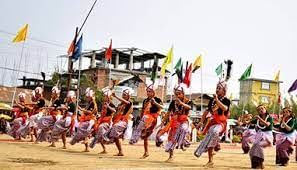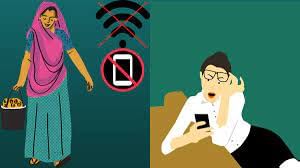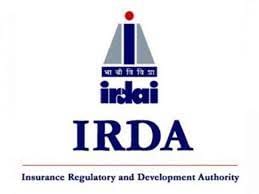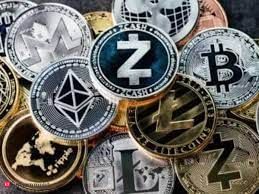UPSC Daily Current Affairs- 9th March 2023 | Current Affairs & Hindu Analysis: Daily, Weekly & Monthly PDF Download
GS-I
Yaoshang Festival
Why in News?
Recently, the five-day-long Yaoshang festival, Manipur’s version of Holi, has begun
About Yaoshang Festival
- The festival is celebrated every year on the full moon of Lamta month (February-March) of the Meitei lunar calendar.
- The festival is celebrated by the Meitei people who are predominantly Hindu.
- It is celebrated at the same time as Holi and is known as ‘Manipur’s version of Holi’.
- The five-day-long celebration begins with the burning of ‘yaoshang’ (a small thatch hut/straw hut) which is constructed with bamboo and straws on the first day
- The highlight of the festival is the ThabalChongba, a traditional Manipuri folk dance where boys and girls hold hands and sing and dance in a circle.
- The festival marks the rejuvenation of the spirit of life and commemorates the birthday of Chaitanya Mahaprabhu.
- Children visit neighbours to ask for a monetary donation which is called
Who are the Meitei people?
- Meiteis are the dominant population of Manipur in northeastern India.
- A majority follow Hinduism while more than 8% are Muslims, locally known as
- The Marup system (literally, "friendship association"), a type of cooperative saving and credit institution, is an intriguing aspect of Meitei village's socio-economic organisation.
- They speak a Tibeto-Burman language, they differ culturally from the surrounding hill tribes by following Hindu customs.
Source: Indian Express
What is a Hailstorm?
Why in News?
The sudden change in the weather conditions in Madhya Pradesh hit the state's farmers as their crops were damaged due to the heavy rain and hailstorm.
About Hailstorm:
- Hail is a type of solid rain made up of balls or lumps of ice.
- Storms that produce hail which reaches the ground are known as hailstorms.
- Conditions for Hailstorms to occur:
- Highly developed Cumulonimbus clouds need to be present. These are the massive anvil or mushroom-shaped clouds that are seen during thunderstorms which can reach heights up to 65,000 feet.
- There must be strong currents of air ascending through these clouds. These currents are commonly known as updrafts.
- The clouds will need to contain high concentrations of supercooled liquid water.
- How are Hails formed?
- It begins as a water droplet that is swept up by an updraft inside of a thundercloud.
- Other supercooled water droplets which are already present inside the cloud will adhere to the water droplet’s surface, forming layers of ice around
- As the water droplet reaches higher elevations within the cloud, it comes into contact with more and more supercooled particles.
- The hail embryo will grow larger and larger as it reaches higher altitudes in the updraft.
- Finally, it will reach a size and weight where gravity will begin to act on it and pull it down.
Source: The Print
GS-II
Bridging the Digital Gender Gap/Digital Divide
Why in News?
Despite progress in closing the global gender gap overall, women and girls continue to be left behind in the digital world.
About the Digital Gender Gap/Digital Divide:
- Digital divide is a term that refers to the gap between demographics and regions that have access to modern information and communications technology, and those that don’t or have restricted access.
- This technology can include the telephone, television, personal computers and the Internet.
- The term “digital gender gap” was coined by UN Women in 2010.
Digital Equity:
- Digital equity on the other hand is about providing everyone with equal opportunities to use technology to improve their lives.
- It includes making sure that everyone has access to the internet and the skills they need to use it effectively.
UNICEF Report:
- According to a UNICEF report, as many as 90% of the jobs in the world today have a digital component.
- These jobs, however, are available only to the digitally able, and to more men than women.
- According to the report, in developing countries, only 41% of women have access to the internet compared with 53% of men.
- Women are 20% less likely to own a smartphone and are more likely to borrow phones from a male family member.
Significance of bridging the Gender Digital Divide:
Benefits to women and to the Nation:
- India aims to have a $1 trillion digital economy by 2025.
- Already, 40% of global digital transactions take place in India.
- In 2022, a staggering 49 billion digital transactions took place in India.
- As economies digitize further, there is every reason to believe that most jobs will require some knowledge of digital technology.
- There are vast opportunities for girls and women to power India’s digital economy and benefit from it.
Can act as a multiplier effect:
- We have the world’s largest young population, and women and girls constitute almost half of it.
- Access to digital technology for a young woman can be a game changer with multiplier effects.
Acting as a solution:
- Giving women access to the internet and teaching them digital skills can help them overcome many of the obstacles they face.
- With internet access, women can gain new knowledge and skills, connect with others, and find new opportunities.
- Digital knowledge can also play a significant role in women’s safety.
- With digital equity, women can be empowered to reach their full potential.
Challenges leading to Gender Digital Divide
Lack of Infrastructure: Being a densely populated country, India needs well established infrastructure to deliver e-services.
- But still there are some rural disconnected regions which are not connected to Internet.
Population: It is a challenge for a developing country to serve a population of 1.30 billion uniformly.
- Every policy and project that is initiated should be implemented at a large scale keeping the future perspectives in mind.
Geographical Diversity: Rural India is still deprived of the facilities of urban India because of its geographical location.
- It is poorly connected in terms of roads and infrastructural facilities.
Illiteracy and Poverty: A large part of population is fighting for its daily basic needs. They do not bother about high speed devices and digitization.
- They are more worried about food and shelter.
- A large portion is illiterate and cannot operate digital devices. According to census 2011, literary rate in India is 74.04%.
Gender Divide: In India, there is huge discrimination among male and female.
- Only 65.46% of Indian women are literate and it is shocking that only 29 percent of Indian internet users are female. This creates a huge gender divide.
Corruption: Corruption is a termite for government. At each tier of government structure, politicians and stakeholders try to draw illegal benefits for themselves.
- Most of the budget that is decided at higher level cannot reach the general public and a large part of it is lost due to mediators.
Lack of Participation: It is observed that often the rural people are not very much attracted towards the web-based E-Governance services for various reasons.
- Many-a-times they are afraid of the technologies and at times they are even ignorant about the availability of technologies which can help in dealing with their problems.
Govt of India Initiatives to promote gender equality in access to technology
- In 2011, the BharatNet project was launched to connect 0.25 million panchayats through optical fibre and connect India’s villages.
- Its implementation began only in 2014, the deadline was extended to August 2021.
- In 2015, the government launched several schemes under its Digital India campaign to connect the entire country.
- This includes the Pradhan Mantri Gramin Digital Saksharta Abhiyan, launched in 2017, to usher in digital literacy in rural India by covering 60 million households.
- Kisan Call centre: The Department of Agriculture & Cooperation launched Kisan Call Centers to deliver extension services to the farming community.
- The purpose of these call centers is to respond to issues raised by farmers, instantly, in the local language.
- Technology Development for Indian Languages (TDIL): The department of information technology initiated the TDIL with the aim of developing information processing tools and techniques to facilitate human-machine interaction without language barrier.
- Digital library of India is an ambitious project of IISc and Ministry of communication and information technology, Government of India.
Way Forward:
- Addressing the divide: Addressing the digital divide requires special, urgent and focused efforts of the government.
- A large investment needs to be made, year after year, in digital infrastructure.
- Need of policy interventions: Bridging the gender gap will require smart interventions specially designed for girls and women in health, education, employment, banking, skilling and transportation.
- A favourable policy environment to promote the digital empowerment of women is a step in the right direction.
- Skills: Digital skills, required today both for life and for livelihoods, must be imparted on a war footing by transforming government digital literacy programmes into skilling missions, and expanding outreach, including through the private sector.
- Online safety of women: Social media sites can use their “algorithm power” to proactively tackle the issue of safety.
- Governments need to strengthen laws that hold online abusers to account, and the public to speak up whenever they witnessed abuse online.
- Example of ‘Digital Sakhis’:
- Young women known as ‘Digital Sakhis’ from Madhya Pradesh are upturning discriminatory social norms through the use of smartphones.
The digital gender gap is not only a modern social evil but also a huge economic constraint. To leave women out of the digital world would amount to denying what today has become a basic skill for survival.
Prime Minister of India recently has emphasized the need for ‘women-led development’ as India took over the G20 presidency. Women20—the G20’s official engagement platform to promote gender equity—identifies “bridging the gender digital divide” as one of its five priorities that need to be mainstreamed as part of the G20 agenda this year.
Source: LiveMint
What is Transit Anticipatory Bail?

Why in News?
The Delhi High Court recently granted transit anticipatory bail to a person in an First Information Report (FIR) lodged against him by the Tamil Nadu police.
About Transit Anticipatory Bail:
- A transit anticipatory bail is sought when a case against a person has been or is likely to be filed in a state different from the one in which the person is likely to be arrested.
- The purpose of transit bail is to allow the person bail, so they can approach the appropriate court in the state in which the case has been filed for anticipatory bail.
- In the absence of transit anticipatory bail, the result would be that another state’s police could arrest a person from their home state without them having the opportunity to apply for anticipatory bail at all.
- The procedure to be followed in transit anticipatory bail is exactly the same as of any other anticipatory bail application.
- The concept of transit anticipatory bail is not codified in Indian law but has found its identity through judicial practice and legal precedents.
What is a Bail?
- Bail is a judicial release of an accused person from custody on the condition that the accused person will appear in court at a later date.
- Sections 436 to 439 of the Criminal Procedure Code deal with the concept of Bail.
- Under the CrPC, bail can be granted to an accused person either by a police officer or by a judicial magistrate.
What is an Anticipatory Bail?
- It is the bail granted to a person in anticipation and apprehending arrest.
- Under Section 438 of CrPC, any individual who discerns that he may be tried for a non-bailable offense can apply for anticipatory bail.
- The application shall be made to the High Court or Sessions Court, where the crime is alleged to be committed.
- Anticipatory Bail is bail before the arrest, and the police can't arrest an individual if the Court has granted anticipatory Bail.
Source: The Hindu
GS-III
Insurance Regulatory and Development Authority of India (IRDAI)
Why in News?
The Insurance Regulatory and Development Authority of India (IRDAI) recently asked the general insurers to talk to transport authorities of 28 states and eight union territories to provide mandatory covers for the uninsured vehicles.
About IRDAI:
- It is an autonomous and statutory body established under the IRDA Act 1999.
- It is the apex body that supervises and regulates the insurance sector in India.
- Objective: To protect the interests of policyholders, to regulate, promote and ensure orderly growth of the insurance industry in India.
- Nodal Ministry: Ministry of Finance
- Head Office: Hyderabad.
- Composition: IRDAI is a 10-member body- a Chairman, five full-time members, and four part-time members appointed by the Government of India.
- Functions:
- To have a fair regulation of the insurance industry while ensuring financial soundness of the applicable laws and regulations.
- Frame regulations periodically so that there is no ambiguity in the insurance industry.
- Registering and regulating insurance companies;
- Protecting policyholders' interests;
- Licensing and establishing norms for insurance intermediaries;
- Promoting professional organizations in insurance;
- Regulating and overseeing premium rates and terms of non-life insurance covers;
- Specifying financial reporting norms of insurance companies;
- Regulating investment of policyholders' funds by insurance companies;
- Ensuring the maintenance of solvency margin by insurance companies;
- Ensuring insurance coverage in rural areas and of vulnerable sections of society.
Source: Indian Express
Cryptocurrencies and Prevention of Money Laundering Act, 2002
Why in News?
Recently, the government announced that trade in cryptocurrency will be covered under India’s money laundering laws.
About Cryptocurrencies:-
- It is any form of currency that exists digitally or virtually and uses cryptography to secure transactions.
- Cryptocurrencies don’t have a central issuing or regulating authority.
- It uses a decentralized system to record transactions and issue new units.
- It is supported by a decentralized peer-to-peer network called the blockchain.
Types of cryptocurrencies
The most common and valued cryptocurrency is Bitcoin.
All the other cryptocurrencies other than Bitcoin are together as a set are known as alternate coins or commonly called “Altcoins”. Most famous alt coins are:-
- Litecoin
- Cardano
- Polkadot
- Stellar(XLM)
- Binance Coin
Advantages:-
- Cryptocurrencies are cheaper to use to execute international transactions because they don’t have to be handled by intermediaries.
- It is faster than other financial instruments.
- With a digital key, access to the currency is protected t.
- Identity Protection: Cryptocurrency can be sent directly to a recipient without any information other than the total amount you want to send.
- Risk-free for sellers: Payments using Cryptocurrency can’t be reversed, which means merchants don’t have to worry about stopped payments.
- Anti-Inflationary Currency: Due to the high demand for cryptocurrency its prices have largely remained on a growing trajectory. In this scenario, people tend to hold more cryptocurrency than spend it.
Disadvantages:-
- Privacy Concerns: All the transaction information is stored in a distributed ledger (called blockchain), which is publicly visible.
- High Volatility
- Destination for black money: The fear among regulators and policymakers is that cryptocurrencies, being an alternative source of value to fiat currency, could be misused to launder black money or finance terrorist activities.
- Cybersecurity Concerns: Cryptocurrencies are prone to cybersecurity breaches and hacks.
- Dark activities: The possibility that the new money will nurture illicit activities and markets like drug selling, weapons, etc. through Darknet is always high using cryptocurrency anonymously.
- Monetary control and economic behavior: It could dramatically change global monetary policymaking.
- Inflation: Governments and policymakers will have a reduced ability to control inflation
Source: AIR
Interstellar Boundary Explorer
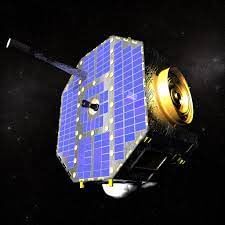
Why in News?
Recently, NASA engineers successfully reset the Interstellar Boundary Explorer (IBEX) spacecraft after it went into contingency mode for 3 weeks.
About Interstellar Boundary Explorer:
- NASA's Interstellar Boundary Explorer (IBEX) was launched in October 2008 to study the outer edge of the heliosphere.
- The spacecraft is designed to map the boundary where winds from the Sun interact with winds from other stars.
- The solar system's boundary is studied by observing energetic neutral atoms or ENAs.
- ENAs are high-energy particles produced at the very edge of our solar system.
- Major discoveries of IBEX
- This spacecraft fully mapped the heliosphere within a year after its launch.
- Its most famous discovery is uncovering a dense region of particles, the ‘IBEX ribbon
What is Heliosphere?
- Heliosphere is the region where the constant flow of particles from our Sun, called the solar wind, collides with material from the rest of the galaxy.
Source: Indian Express
|
57 videos|5393 docs|1142 tests
|
FAQs on UPSC Daily Current Affairs- 9th March 2023 - Current Affairs & Hindu Analysis: Daily, Weekly & Monthly
| 1. What is the significance of GS-I, GS-II, and GS-III in UPSC exams? |  |
| 2. How can I prepare for the GS-I paper in the UPSC exam? |  |
| 3. What are the topics covered in the GS-II paper of the UPSC exam? |  |
| 4. How can I improve my performance in the GS-II paper of the UPSC exam? |  |
| 5. What are the topics covered in the GS-III paper of the UPSC exam? |  |

